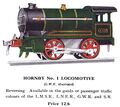Category:Hornby No1 locomotives
| Hornby Series Loco | ||
|---|---|---|
Hornby No1 locomotives | ||
| under development | ||
| Tin/M | 0-4-0 | 1920- |
| HT/No.1 | 0-4-0 | 1920 |
| No.2 | 4-4-0 | 1921 |
| ZuluT/No1T | 0-4-0 | 1922 |
| Zulu/No0 | 0-4-0 | 1923 |
| No.2T | 4-4-4 | 1923 |
| Metropolitan | 1925 | |
| Riv/No.3 | 4-4-2 | 1926 |
| No1Sp | 0-4-0 | 1929 |
| No.1SpT | 0-4-0 | 1929 |
| No.2Sp | 4-4-0 | 1929 |
| No.2SpT | 4-4-2 | 1929 |
| 4 Eton | 4-4-0 | 1937 |
| Princess | 4-6-2 | 1937 |
| "Hornby Trains" | ||
| (Post-War) | (0-4-0) | (-) |
The Hornby No.1 line of model locomotives represented a central almost-constant strand running through the history of Hornby gauge 0, from the first 1920 "The Hornby Clockwork Locomotive" to the last gauge 0 locos made by Hornby, the No.50/51 models.
Evolution
The Hornby Clockwork Train quickly evolved into The Hornby No.1 Locomotive when Meccano Ltd.'s Hornby Trains and Zulu Trains ranges were merged under a single brandname. The Hornby Loco had a single flat-topped splashguard over the rear drivewheels, a feature that was inherited by the No.1 loco.
The 1927 versions of the No.1 loco now had proper loco numbers on the sides, the steam domes were painted to match the bodywork instead of being brass-coloured, and the curved-fronted, flat-topped splasher panels were now extended forwards to cover both wheels.
Although the design was continuously tweaked and adjusted, the next obvious cosmetic change didn't happen until after production restarted following WW2, when the range was restructured. The main Hornby Series rolling stock became the 50 Series range, with the No.1 loco becoming the No.501 loco, which could be easily distinguished from the earlier pre-1957 production by its semi-matte paintwork.
Finally, in 1954, the Hornby gauge 0 locomotives bowed out with the No.50 and No.51 locomotives (in black, and green, respectively), which returned to the more traditional gloss paintwork.
Further Reading
- Peter Randall, The No.1 Loco Meccano Magazine July 1978, pages 94-95
Pages in category ‘Hornby No1 locomotives’
The following 5 pages are in this category, out of 5 total.
Media in category ‘Hornby No1 locomotives’
The following 11 files are in this category, out of 11 total.
- Hornby No.1 Goods Set, LNER (1925 HBoT).jpg 1,868 × 771; 211 KB
- Hornby No.1 Passenger Set, LMS (1925 HBoT).jpg 2,831 × 936; 530 KB
- Hornby No.1 Passenger Set, LNER (1925 HBoT).jpg 2,850 × 942; 535 KB
- Hornby No1 Goods Train (MM 1924-03).jpg 1,928 × 726; 168 KB
- Hornby No1 Locomotive GW 2449 (HBoT 1930).jpg 962 × 496; 89 KB
- Hornby No1 Locomotive LNER 5097 (HBoT 1930).jpg 1,031 × 527; 93 KB
- Hornby No1 Locomotive, GWR 4300 (HBoT 1934).jpg 1,920 × 1,709; 346 KB
- Hornby No1 Passenger Train (MM 1924-03).jpg 1,999 × 765; 178 KB
- The Hornby Clockwork Train, open box.jpg 592 × 685; 72 KB
- The Hornby Clockwork Train.jpg 1,189 × 1,440; 236 KB
- Zulu locomotive and tender, 1920s, detail.jpg 1,024 × 768; 359 KB









